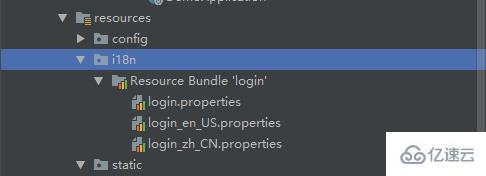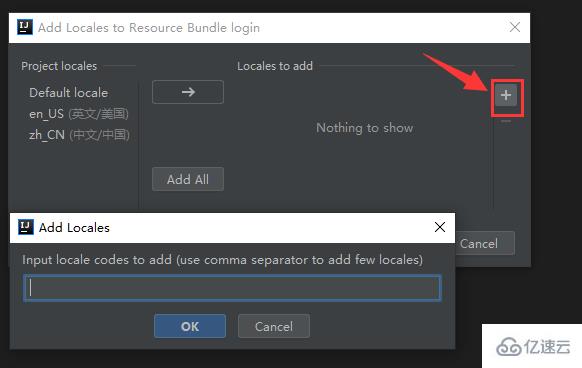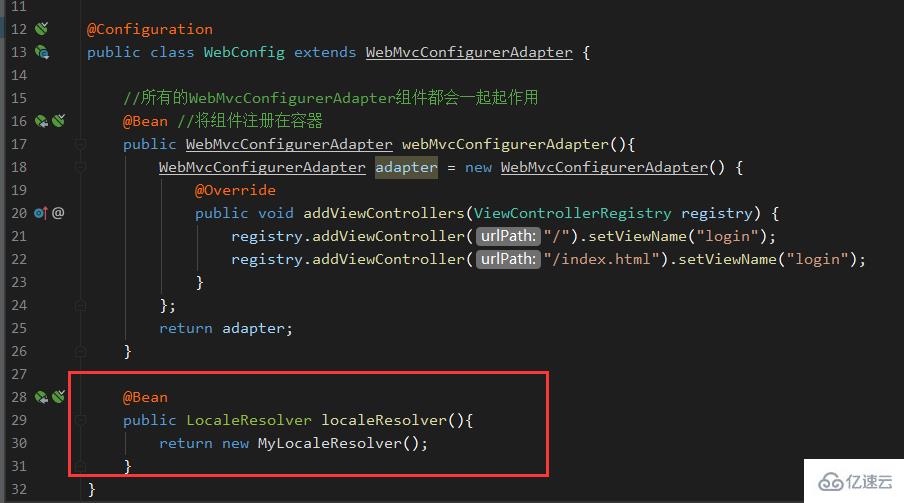这篇文章主要介绍了SpringBoot怎么实现国际化的相关知识,内容详细易懂,操作简单快捷,具有一定借鉴价值,相信大家阅读完这篇SpringBoot怎么实现国际化文章都会有所收获,下面我们一起来看看吧。
国际化这个功能可能我们不常用,但是在有需要的地方还是必须要上的,今天就来看一下怎么在我们的web开发中配置国际化,让我们的网站可以根据语言来展示不同的形式。
springboot已经自动配置好了管理国际化资源文件的组件:
@ConfigurationProperties(prefix = "spring.messages")
public class MessageSourceAutoConfiguration {
/**
* Comma-separated list of basenames (essentially a fully-qualified classpath
* location), each following the ResourceBundle convention with relaxed support for
* slash based locations. If it doesn't contain a package qualifier (such as
* "org.mypackage"), it will be resolved from the classpath root.
*/
private String basename = "messages";
//我们的配置文件可以直接放在类路径下叫messages.properties;
@Bean
public MessageSource messageSource() {
ResourceBundleMessageSource messageSource = new ResourceBundleMessageSource();
if (StringUtils.hasText(this.basename)) {
//设置国际化资源文件的基础名(去掉语言国家代码的)
messageSource.setBasenames(StringUtils.commaDelimitedListToStringArray(
StringUtils.trimAllWhitespace(this.basename)));
}
if (this.encoding != null) {
messageSource.setDefaultEncoding(this.encoding.name());
}
messageSource.setFallbackToSystemLocale(this.fallbackToSystemLocale);
messageSource.setCacheSeconds(this.cacheSeconds);
messageSource.setAlwaysUseMessageFormat(this.alwaysUseMessageFormat);
return messageSource;
}从上边的源码我们可以看出,我们的国际化资源文件可以直接起名字为messages.properties,springboot就会自动识别,其实相当于在配置文件中添加了一个spring.messages.basename=messages,如果我们指定一个xxx.properties作为国际化文件,那么我们就指定
spring.messages.basename=xxx就可以了,springboot会自动的找到以xxx开头的properties,根据语言和国家代码,找到相应的xxx_zh_CN.properties(中文_中国)、xxx_en_US.properties(英文_美国)来选择其中的资源值作为当前页面中所要渲染的值。
我们新建一个名称为i18n的文件夹,在里边添加3个配置文件,分别是login.properties(默认无语言选择时的配置),login_zh_CN.properties(中文语言配置),login_en_US.properties(英文语言配置),默认的格式为:文件名_区域_语言.properties;当我们这样命名生成文件后,IDEA也会帮我们识别这是个国际化配置包,自动转换成如下的模式,上边附带一个Resource Bundle 'login'的文件夹,右键在这个文件夹上点击,就可以方便的添加其他语言的配置:



分别在三个配置文件中写入配置:
login.properties:
login.btn=登陆~
login.password=密码~
login.remember=记住我~
login.tip=请登陆~
login.username=用户名~login_zh_CN.properties:
login.tip=请登录
login.username=用户名
login.password=密码
login.btn=登录
login.remember= 记住我login_en_US.properties:
login.tip=Please sign in
login.username=Username
login.password=Password
login.btn=Sign in
login.remember = Remember Me然后我们的主配置文件application.properties中添加如下配置,启用我们自定义的资源文件:
spring.messages.basename=i18n.login这里我们以之前的thymeleaf语法来添加一个登录页面来进行测试:
<!DOCTYPE html>
<html lang="en" xmlns:th="http://www.thymeleaf.org">
<head>
<meta http-equiv="Content-Type" content="text/html; charset=UTF-8">
<meta name="viewport" content="width=device-width, initial-scale=1, shrink-to-fit=no">
<meta name="description" content="">
<meta name="author" content="">
<title>Signin Template for Bootstrap</title>
<!-- Bootstrap core CSS -->
<link th:href="@{/webjars/bootstrap/4.0.0/css/bootstrap.css}" rel="stylesheet">
<!-- Custom styles for this template -->
<link th:href="@{/asserts/css/signin.css}" rel="stylesheet">
</head>
<body class="text-center">
<form class="form-signin" action="dashboard.html" th:action="@{/user/login}" method="post">
<img class="mb-4" th:src="@{/asserts/img/bootstrap-solid.svg}" src="asserts/img/bootstrap-solid.svg" alt="" width="72" height="72">
<h2 class="h4 mb-3 font-weight-normal" th:text="#{login.tip}">Please sign in</h2>
<!--判断-->
<p style="color: red" th:text="${msg}" th:if="${not #strings.isEmpty(msg)}"></p>
<label class="sr-only" th:text="#{login.username}">Username</label>
<input type="text" name="username" class="form-control" placeholder="Username" th:placeholder="#{login.username}" required="" autofocus="">
<label class="sr-only" th:text="#{login.password}">Password</label>
<input type="password" name="password" class="form-control" placeholder="Password" th:placeholder="#{login.password}" required="">
<div class="checkbox mb-3">
<label>
<input type="checkbox" value="remember-me"/> [[#{login.remember}]]
</label>
</div>
<button class="btn btn-lg btn-primary btn-block" type="submit" th:text="#{login.btn}">Sign in</button>
<p class="mt-5 mb-3 text-muted">© 2017-2018</p>
<a class="btn btn-sm" th:href="@{/index.html(lang='zh_CN')}">中文</a>
<a class="btn btn-sm" th:href="@{/index.html(lang='en_US')}">English</a>
</form>
</body>
</html>#{login.username} 会直接从国际化的资源文件中取到我们所配置的值,根据不同的语言会切换为不同的语言配置,默认是根据浏览器的语言来判断的,我们可以按照以下方式来设置浏览器的语言来查看效果,在谷歌浏览器的设置里边搜索语言,然后添加一个英文语言,设置语言的顺序来设置首选语言,如下所示:

我们也可以查看浏览器发送的请求头部分来确定语言是否 设置成功:

从上边我们可以看出,默认的是从请求头中解析语言文化的,我们可以设置自己的解析器,比如访问页面的查询参数中来解析语言,下边是我们的登录页面,我们可以添加两个按钮,当点击按钮的时候,重新跳转index.html页面,并附带上一个lang的参数:

可以查看网页源代码,我们生成的链接:

html关键代码,用thymeleaf生成,也可以自己手写:
<button class="btn btn-lg btn-primary btn-block" type="submit" th:text="#{login.btn}">Sign in</button>
<p class="mt-5 mb-3 text-muted">© 2017-2018</p>
<a class="btn btn-sm" th:href="@{/index.html(lang='zh_CN')}">中文</a>
<a class="btn btn-sm" th:href="@{/index.html(lang='en_US')}">English</a>添加我们自己的解析器MyLocaleResolver,从请求参数中获取lang,根据lang的值来设置不同的Locale:

package com.example.demo.component;
import org.springframework.util.StringUtils;
import org.springframework.web.servlet.LocaleResolver;
import javax.servlet.http.HttpServletRequest;
import javax.servlet.http.HttpServletResponse;
import java.util.Locale;
public class MyLocaleResolver implements LocaleResolver {
@Override
public Locale resolveLocale(HttpServletRequest httpServletRequest) {
String lang = httpServletRequest.getParameter("lang");
Locale locale = Locale.getDefault();
if(!StringUtils.isEmpty(lang)){
String[] parts = lang.split("_");
locale = new Locale(parts[0],parts[1]);
}
return locale;
}
@Override
public void setLocale(HttpServletRequest httpServletRequest, HttpServletResponse httpServletResponse, Locale locale) {
}
}在WebConfig添加如下代码,把这个MyLocaleResolver添加到容器中去,springboot发现到有LocaleResolver的新实例,就会用这个解析器:

重新编译启动就可以了,点击不同语言跳转不同链接,显示不同的语言:

关于“SpringBoot怎么实现国际化”这篇文章的内容就介绍到这里,感谢各位的阅读!相信大家对“SpringBoot怎么实现国际化”知识都有一定的了解,大家如果还想学习更多知识,欢迎关注亿速云行业资讯频道。
亿速云「云服务器」,即开即用、新一代英特尔至强铂金CPU、三副本存储NVMe SSD云盘,价格低至29元/月。点击查看>>
免责声明:本站发布的内容(图片、视频和文字)以原创、转载和分享为主,文章观点不代表本网站立场,如果涉及侵权请联系站长邮箱:is@yisu.com进行举报,并提供相关证据,一经查实,将立刻删除涉嫌侵权内容。